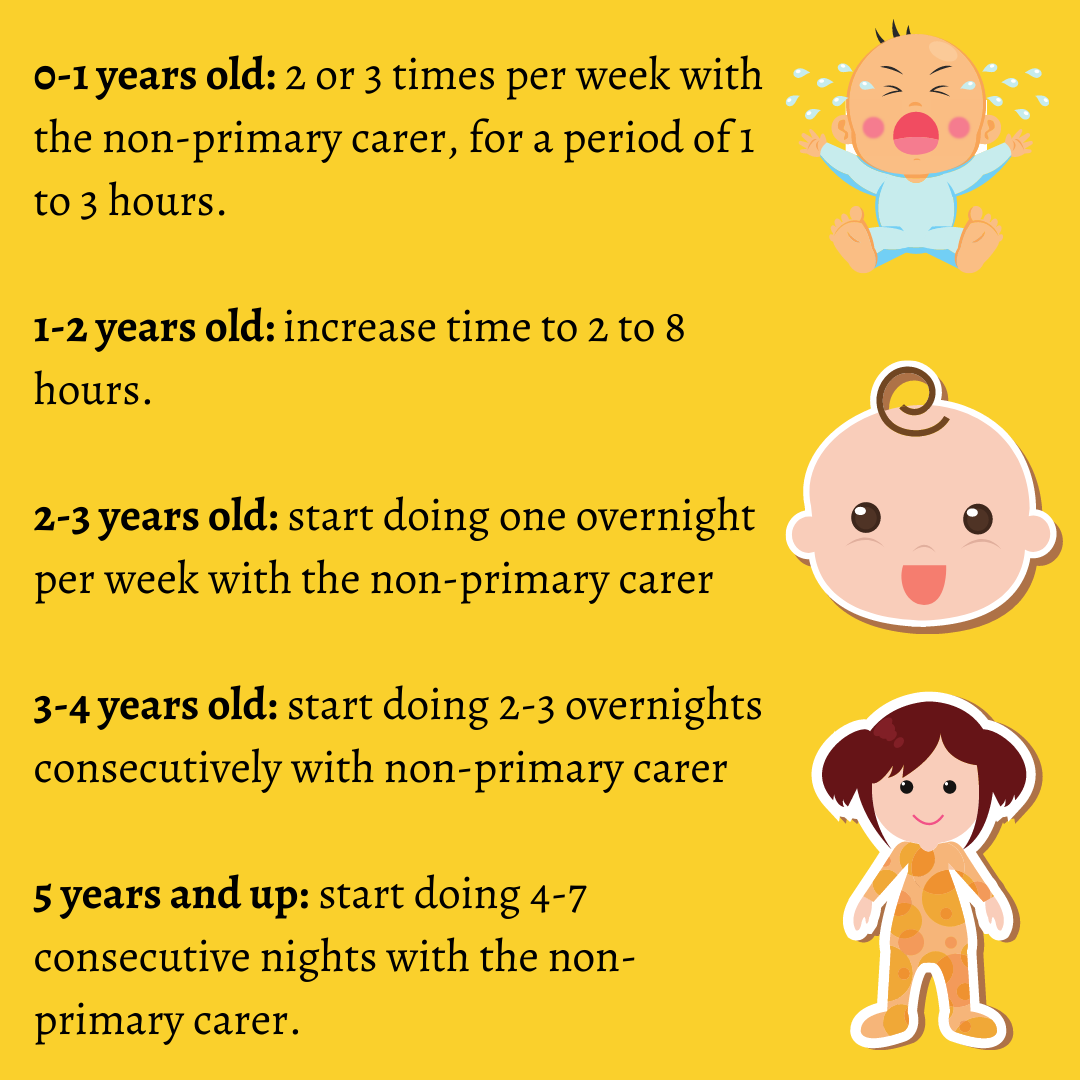Devising custody agreements after separation and divorce can be time-consuming and emotionally draining for the parents and children involved.
Putting the custody arrangements into practice and figuring out the best-shared custody agreements for your family can be difficult, especially if you feel in the dark about the options available.
The traditional weekdays with mum and every alternate weekend with dad is no longer the standard child custody arrangements.
Child Custody Agreements & Family Law
If two former partners agree on the parenting arrangements for their children, they can apply to the Family Court for consent orders. This makes the decision a formal, legal agreement. If no agreement can be reached on how to arrange custody of the children, the court will then make orders about the sharing of parental responsibility.
Parental responsibility is the responsibility a person has for their children until the children reach 18 years of age.
Divorce and remarriage do not change or diminish parental responsibility.
In the Family Law Act 1975 it is clear that all arrangements must be made in the best interests of the child.
The court considers many factors when making a parenting order, including the child’s own views, their level of maturity and understanding of the situation, their relationship with other relatives such as grandparents, the practical and financial difficulties of a child spending time with each parent, the parents’ abilities to care for their child and any family violence.
If violence or abuse has occurred within the child’s family, the court will concentrate on protecting the child from harm.
A court may order that there is shared parental responsibility.
Apart from custody, this also means that any important, long-term decisions for or about a child must be made equally by the parents.
The two people must genuinely cooperate to come to a joint decision.
Shared custody in a practical sense comes in many forms.

1. Alternate Weekend – Shared Custody Arrangement
This is what comes to mind for most people when they think of joint custody arrangements.
This shared custody arrangement results in one parent having the children every alternate weekend, typically from Friday after school until Sunday evening or Monday morning.
This approach has become less popular over the years, as it normally results in one parent becoming the ‘fun parent’ and the other parent having a skewed relationship with their children.
2. Alternate Weeks – Joint Custody Arrangement
The parents have split up and lived in different places, so they ferry the children between them each week.
Generally, changeovers happen on a weekend.
With this arrangement, the children do have roughly equal time with each parent on an alternating basis, but some families may find that going one week with only seeing one parent is not ideal.
For this arrangement to work, parents will need to live relatively close to one another to allow the children to have access to the same schools, friends and extracurricular activities.
3. Alternating Weeks with a Visit
In this case, families can work out a schedule in which each parent visits the children during their off-week.
For example, if the children had been picked up by their father on Sunday evening and were living with him for the week, their mother would come and visit on Wednesday afternoon.
The same thing would happen vice versa while the kids were staying at their mother’s house.
This can be particularly helpful for younger children.
This shared custody arrangement works if the parents live relatively near to each other. It is important to factor in the necessary driving or travel time.
4. School Holidays
In the event that parents live a considerable distance from one another, they may have to consider that one parent has care of the children during the school term. The other parent will then have the children during the school holidays.
This may mean that the second parent may have to travel to where the children live, or that the children may have to travel to where the second parent lives.
This will be dependant on the age of the children and the locations of the parents.
One thing that may not come up in the day-to-day organisation of custody plans is the question of holidays.
This is unique to each family. Holidays such as Christmas and New Year may also be managed on an alternating basis, decided well in advance, but there is no single right way to manage joint custody.
School holidays can also entail changes to the regular custody routine, and families can make different decisions about how much time is spent with each parent as they see fit.
The most important aspect of custody agreements is that all decisions are made according to the children’s best interest.
A mediation service like Relationships Australia may be able to help you agree to your child custody arrangement.
It is important to make the transition to joint custody as smooth and easy for them as possible.
Also read: Should Separated Parents Share Travelling?
5. Two-Two-Three
It is important to remember that a week-by-week custody schedule is not the only option.
A two-two-three custody schedule means the children stay with one parent on Monday and Tuesday, the other parent on Wednesday and Thursday, and back with the first parent for a three-day weekend, and then vice versa the following week.
The ease of this as an option depends on the age of the children and how much stress moving between homes so frequently may place on them.
Such short-term stays with each parent would work best for ex-partners who live quite nearby. Otherwise, the time spent travelling would really add up.
6. Parents Moving In and Out of the Children’s House
The above two situations mean the children need two functioning bedrooms with everything they need, from clothes and school uniforms to books and phone chargers.
The two-house arrangement works well enough for many families, but what if the kids had their own house and the parents moved in and out each week?
Some parents may purchase or rent a home that their children live in permanently while they are the ones going to and fro on a weekly basis, living half the time in another house.
This may provide a certain sense of stability for the children, and it does cancel out the problems that can come with two homes: no more leaving the homework at Dad’s house by accident.
Things to Consider for Child Custody Arrangements in Australia
Each family has unique needs, and custody schedules should fit well to accommodate the children’s and parents’ lifestyles.
The aim is to try to disrupt the children’s lives as little as possible.
Most people will adjust child custody schedules by age.
Arranging a child custody schedule by age allows parents to take into account the needs and the schedules of children, and change them as the child gets older.
Child custody arrangements by age in Australia
Generally, child custody arrangements by age are structured in the following 5 tiers. There is no set rule as to how child custody arrangements by age should work, however, below is a rough guide:
0-1 years old: child should spend frequent time (2 or 3 times per week) with the non-primary carer, for a short period of 1 to 3 hours.
1-2 years old: child can start longer time with the non-primary carer, for a period of 2 to 6 hours.
2-3 years old: child may start doing one overnight per week with non-primary carer
3-4 years old: child may start doing 2-3 overnights consecutively with non-primary carer
5 years and up: child may start doing 4-7 consecutive nights with the non-primary carer.

So the best custody arrangements for toddlers would mean that the toddler lives in one parents house, and spends frequent time with the other parent, eventually building up to one night per week.
We are not saying that this is without a doubt the best custody arrangement for toddlers across Australia – each child is different so you will have to assess how your toddler is coping.
Remember that the custody arrangement and schedules must work with extra-curricular activities and school hours, for example, an early music practice once a week or sport on Saturday mornings.
Flexible working hours for parents are clearly advantageous, but this is not the reality for the majority of families.
Custody schedules must accommodate parents’ work hours and the travel time it takes between work, home, and their ex-partners home.
Also read: Reasons to Deny Overnight Visitation in Australia
Consider Living Conditions, Travel Requirements and Comfort Level
When making custody arrangements for toddlers, it’s also important to remember the practicalities of the toddler’s living conditions.
Keep in mind the travel requirements of the arrangements, and try to minimise the disruption that travel can cause to a toddler’s routine.
In addition, parents should still strive to ensure a comfortable level of contact between the parents and the toddler during all exchanges of custody. Ideally, contact between the two parents should remain civil or amicable, or if this is not possible, professional or efficient. Separated parents should also strive to communicate openly on any issues involving the parenting arrangements for the toddler.
Check In Regularly
Finally, it’s important to remember that parenting arrangements for toddlers need to remain flexible, and that parental commitments should be checked in with regularly.
As children age, their needs change, become more advanced and their separation from their parents more mature. What works for toddlers now may not work in a few months’ time.
At Justice Family Lawyers, we understand that making a complex transition from one family to two can be daunting, but we’re here to help. Our experienced lawyers can help guide you through this process and create parenting arrangements that are tailored to help your little ones transition seamlessly to two separate households.
If you and your former partner are separated and are looking to create workable and successful parenting arrangements for your toddler, get in touch with our experienced family lawyers today.
Principal of Justice Family Lawyers, Hayder specialises in complex parenting and property family law matters. He is based in Sydney and holds a Bachelor of Law and Bachelor of Communications from UTS.






